On 15 October 1550 Jan van Scorel, originally from Schoorl [in the Netherlands], and later promoted to the position of a canon in Utrecht, received the royal patent for his invention of a method of dike-building that used anchored blocks. It was a technique he developed for the purpose of reclaiming the Zijpe. That same year, he won a silver cup for restoring the famed Lamb of God by Jan van Eyck of Ghent. The modern reader will think: he must have been a chemist-inventor. But no, we are dealing here with one of those widely gifted individuals of the Renaissance, who in the end – as happened so often – became famous for his works of art.
Jan van Scorel was a typical Renaissance man, and that refers to more than just his painting style. One senses it in the way he describes himself on his earliest known work - pictoris artis amator – a ‘lover of painted art’. When he painted this Holy Kinship altarpiece in 1520, in a late Gothic style reminiscent of his teacher, Jacob Cornelisz, he already acted no longer like an artisan but more like a proud, iberated artist. That’s also why he never joined a guild, which he considered unqualified to promote art for art’s sake.
We can be very thankful for the opportunity to see this altarpiece from Obervellach in Austria at the exhibition of Jan van Scorel’s work in the Centraal Museum in Utrecht – not just because it has never before been removed from its village church but also because it represents the early work of Scorel in such a splendid way.
The young Scorel had left Holland to travel to Nuremberg, where he also met Dürer, and there enjoyed the patronage of an important noble family from Kärnten (Austria); he travelled with them to their ancestral castle where he painted this first-rate masterpiece, a testimony to his great talent – especially since he was only 25 years old at the time. Soon thereafter he went to Venice, and there it was inevitable that a man so in touch with the spirit of Italian Renaissance culture would be influenced by Italian art. In 1521 he went to Rome, where Adrian from Utrecht had just become pope. This compatriot gave him one of the most enviable positions that an artist of that day could have wished for – he became Raphael’s successor and was given the studio that the previous pope had furnished for Leonardo da Vinci. Unfortunately for van Scorel this did not last long, for in 1524 Adrian died and the artist returned north, enriched by a thorough knowledge of the work of Raphael and Michelangelo. So van Scorel became the one who introduced our country [the Netherlands] to this new Renaissance art, not as a slavish follower but as a man spiritually and artistically permeated with ideas and knowledge still new to the North.
The exposition in Utrecht is a beautiful testimony to his art. Certainly, his work lacks the seasoned maturity of the greatest Renaissance artists but, on the other hand, it has a freshness and clarity of colouring, a liveliness in composition, a beautifully mature rendering of landscape backgrounds and a pervading lucidity that makes viewing his work a special experience. See for instance his Entry into Jerusalem, the Baptism in the Jordan and the valuable Mary Magdalene from the Rijksmuseum as well as the beautiful Madonna from New York.
Even more poignant is Jan van Scorel’s portraiture. How accurately and individually he could depict his subjects – so beautifully positioned against the background, with finely balanced light and dark contrasts. In these wonderful, delicately-painted portraits, van Scorel’s art reaches its culmination: Agatha van Schoonhoven, The Jerusalem pilgrims, The twelve-year-old boy. As an agent of renewal, van Scorel strongly influenced the further development of sixteenth-century painting in the Northern Netherlands, also through his very important pupil Maerten van Heemskerck. The latter’s early work, painted under the influence of van Scorel, shows us a powerful and gifted artist, maybe even greater than his master. The family portrait from Kassel is stunning, one of the most impressive pieces painted in this time. The story goes that Jan van Scorel became so jealous of this pupil that he booted him out of his studio.
The exposition shows many more works by portraitists and painters of biblical scenes who were directly influenced by Jan van Scorel. Thus this is also an exhibition of great scientific importance, addressing many hitherto unresolved art-historical problems. But it is foremost an exhibition that offers the enjoyment of works of superior quality to every lover of art – especially of portraits and biblical scenes of powerful persuasiveness.
Originally published in Dutch in Trouw, no date (between 1949 and 1956).
Published in English in M. Hengelaar-Rookmaaker (ed.): H.R. Rookmaaker:
The Complete Works 1, Piquant – Carlisle, 2003.
%20(1).png)












